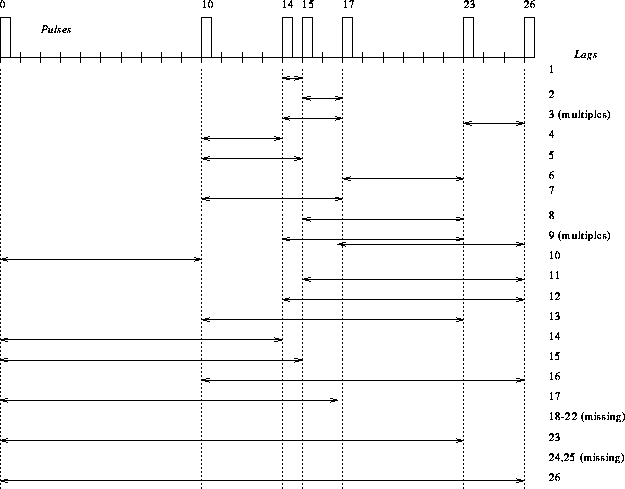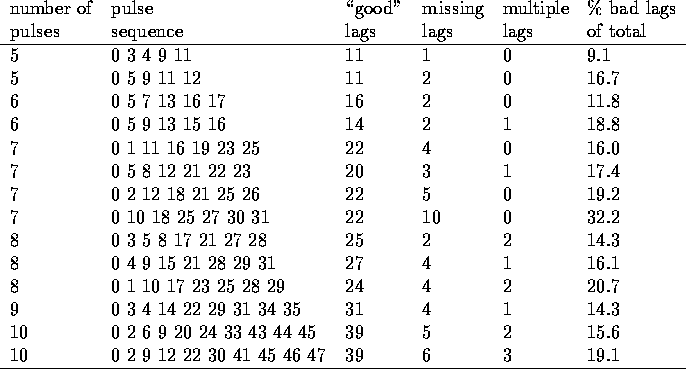 [BG
[BG
With multi-pulse techniques, one seeks to transmit a
pattern of pulses such that the pulse separations contain most or all of the
lags necessary for determining the ACF and such that there is little or
no ambiguity in the ranges that contribute to any given lag. This technique
is considerably more efficient than the variable-lag double-pulse technique
from an analysis point of view; it requires far less time. Some minor
problems with the technique are the presence of increased noise background
due to uncorrelated scatter and the occurrence of missing samples when the
transmitter is operating during sampling
 [BG
[BG ![]() 88, GBV83].
Figure 3.5 shows the details of sequencing and ACF generation
for different lags of a pulse sequence that will be presented later in
Table 3.3.
88, GBV83].
Figure 3.5 shows the details of sequencing and ACF generation
for different lags of a pulse sequence that will be presented later in
Table 3.3.

Figure 3.5: Pulse combinations to generate 17 usable lags from a 7 pulse
sequence
As can be seen, many combinations are possible. Several lags are not usable
because they are either missing or ambiguous. Lags become ambiguous if they
occur more than once within the sequence. If the two
pulses are separated by a lag time t and scattering occurs at two ranges
separated by a distance ![]() , the signals from these two target
regions would arrive back at the same time (pulse 1 from the range
, the signals from these two target
regions would arrive back at the same time (pulse 1 from the range ![]() and pulse 2 from the range R), so a resolution of these
ranges would not be possible. If on the other hand this time t corresponds to a
distance that is larger than the extent of the scattering region, the
multiple pulse-pattern can be used. An important feature is the long
separation of the first pulse from the other pulses. The reason is
that the determination of the scattering intensity is based upon the
zero-lag value of the ACF, which requires essentially a single pulse.
Therefore an optimum pulse sequence has to meet several requirements which
are listed below.
and pulse 2 from the range R), so a resolution of these
ranges would not be possible. If on the other hand this time t corresponds to a
distance that is larger than the extent of the scattering region, the
multiple pulse-pattern can be used. An important feature is the long
separation of the first pulse from the other pulses. The reason is
that the determination of the scattering intensity is based upon the
zero-lag value of the ACF, which requires essentially a single pulse.
Therefore an optimum pulse sequence has to meet several requirements which
are listed below.
The pulse sequence presented in Figure 3.5 is not the only one and by far not the best one possible. The generation of new pulse sequences can be accomplished easily with a simple computer program using a ``brute-force'' method that generates and tests simply all possible sequences. Its functional steps can be summarized as follows.


For example the input of ![]() and M=2 would generate
and M=2 would generate ![]() sequences which are: (0,1,2),(0,1,3),(0,2,3) and (0,2,4).
A typical run of the optimized C-program on a personal computer (486DX2-66)
takes between 10 minutes to 24 hours to complete depending on the values of
sequences which are: (0,1,2),(0,1,3),(0,2,3) and (0,2,4).
A typical run of the optimized C-program on a personal computer (486DX2-66)
takes between 10 minutes to 24 hours to complete depending on the values of
![]() and M. Table 3.3 lists
some possible pulse sequences from the computer analysis,
using the above algorithm. The number of ``good'' lags in the table is
equivalent to the number of ACF data points that can be generated, including
the lag-0 value
and M. Table 3.3 lists
some possible pulse sequences from the computer analysis,
using the above algorithm. The number of ``good'' lags in the table is
equivalent to the number of ACF data points that can be generated, including
the lag-0 value . Not all requirements for a good multipulse
sequence are always met by these examples, but they provide some very
efficient sequencing possibilities.
. Not all requirements for a good multipulse
sequence are always met by these examples, but they provide some very
efficient sequencing possibilities.

Table 3.3: Examples of optimized multi-pulse patterns